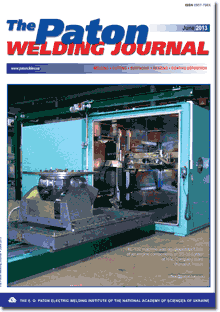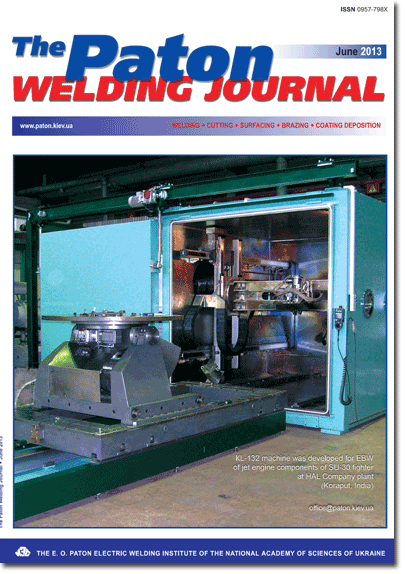| 2013 №06 (07) | 2013 №06 (09) |

The Paton Welding Journal, 2013, #6, 43-45 pages
WEAR RESISTANCE OF DEPOSITED METAL OF THE TYPE OF CARBON AND CHROMIUM-MANGANESE STEELS UNDER THE CONDITIONS OF DRY SLIDING FRICTION OF METAL OVER METAL
V.D. KUZNETSOV1, D.V. STEPANOV1, V.A. MAKOVEJ1 and Ya.P. CHERNYAK2
1NTUU «Kiev Polytechnic Institute», Kiev, Ukraine. E-mail: v.kuznetsov@kpi.ua
2E.O. Paton Electric Welding Institute, NASU, Kiev, Ukraine. E-mail: office@paton, kiev.ua
Abstract
Parts subjected to intensive wear are made from medium- and high-carbon unalloyed or low-alloyed structural steels. Increased carbon content ensures a high hardness and strength of materials. Because of low-alloying, however, their wear resistance is on a relatively low level. High carbon content considerably complicates the technology of reconditioning the above parts, because of the risk of cold cracking in arc surfacing. To recondition this type of parts it is rational to apply consumables producing deposited metal with the structure of metastable austenite. Such a structure can be produced at application of consumables alloyed by chromium and manganese for surfacing. Preliminary work hardening or work hardening directly during service leads to decomposition of metastable austenite and increase of hardness and wear resistance of the deposited metal. The objective of the work was investigation of wear resistance of deposited metal of chromium-manganese class under the conditions of dry sliding friction of metal over metal. Wear resistance of deposited metal of various alloying systems was studied. It is shown that the correlation between hardness and wear resistance is manifested not in all the cases, both for carbon and for austenitic materials. It is found that materials with the structure of metastable austenite are superior to carbon steels as to wear resistance and are preferable at reconditioning of parts from structural medium- and high-carbon steels. 6 Ref., 1 Table, 3 Figures.
Keywords: arc surfacing, surfacing consumables, sliding friction, wear resistance, structure, hardness
Received: 21.03.13
Published: 28.06.13
References
1. Frumin, I.I. (1961) Automatic electric arc surfacing. Kharkov: Metallurgizdat.
2. Ryabtsev, I.A., Kondratiev, I.A. (1999) Mechanized electric arc surfacing of metallurgical equipment parts. Kiev: Ekotekhnologiya.
3. Ryabtsev, I.A. (2004) Surfacing of machine and mechanism parts. Kiev: Ekotekhnologiya.
4. Kuskov, Yu.M., Skorokhodov, V.N., Ryabtsev, I.A. et al. (2001) Electroslag cladding. Moscow: Nauka i Tekhnologiya.
5. Kalensky, V.K., Chernyak, Ya.P., Vasiliev, V.G. et al. (2001) Heat input influence on formation of tears in high-carbon steel building-up with austenitic wires. The Paton Welding J., 11, 9-12.
6. Chernyak, Ya.P. (2007) Comparative evaluation of wear resistance of electrode materials applied for reconditioning tram rails. Ibid., 12, 33-35.
Suggested Citation
V.D. KUZNETSOV1, D.V. STEPANOV1, V.A. MAKOVEJ1 and Ya.P. CHERNYAK2 (2013) WEAR RESISTANCE OF DEPOSITED METAL OF THE TYPE OF CARBON AND CHROMIUM-MANGANESE STEELS UNDER THE CONDITIONS OF DRY SLIDING FRICTION OF METAL OVER METAL. The Paton Welding J., 06, 43-45.The cost of subscription/purchase order journals or individual articles
| Journal/Currency | Annual Set | 1 issue printed |
1 issue |
one article |
| TPWJ/USD | 384 $ | 32 $ | 26 $ | 13 $ |
| TPWJ/EUR | 348 € | 29 € | 24 € | 12 € |
| TPWJ/UAH | 7200 UAH | 600 UAH | 600 UAH | 280 UAH |
| AS/UAH | 1800 UAH | 300 UAH | 300 UAH | 150 UAH |
| AS/USD | 192 $ | 32 $ | 26 $ | 13 $ |
| AS/EUR | 180 € | 30 € | 25 € | 12 € |
| SEM/UAH | 1200 UAH | 300 UAH | 300 UAH | 150 UAH |
| SEM/USD | 128 $ | 32 $ | 26 $ | 13 $ |
| SEM/EUR | 120 € | 30 € | 25 € | 12 € |
| TDNK/UAH | 1200 UAH | 300 UAH | 300 UAH | 150 UAH |
| TDNK/USD | 128 $ | 32 $ | 26 $ | 13 $ |
| TDNK/EUR | 120 € | 30 € | 25 € | 15 € |
AS = «Automatic Welding» - 6 issues per year;
TPWJ = «PATON WELDING JOURNAL» - 12 issues per year;
SEM = «Electrometallurgy Today» - 4 issues per year;
TDNK = «Technical Diagnostics and Non-Destructive Testing» - 4 issues per year.


